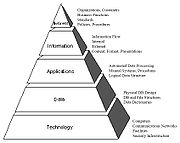
NIST Enterprise Architecture Model
Encyclopedia

Enterprise architecture
An enterprise architecture is a rigorous description of the structure of an enterprise, which comprises enterprise components , the externally visible properties of those components, and the relationships between them...
, that illustrates the interrelationship of enterprise business, information, and technology environments.
This model developed by the National Institute of Standards and Technology
National Institute of Standards and Technology
The National Institute of Standards and Technology , known between 1901 and 1988 as the National Bureau of Standards , is a measurement standards laboratory, otherwise known as a National Metrological Institute , which is a non-regulatory agency of the United States Department of Commerce...
(NIST) in 1989, became in the 1990s widely accepted and promoted within the U.S. federal government
Federal government of the United States
The federal government of the United States is the national government of the constitutional republic of fifty states that is the United States of America. The federal government comprises three distinct branches of government: a legislative, an executive and a judiciary. These branches and...
as an Enterprise Architecture management tool.
This NIST Enterprise Architecture Model is the foundation of several U.S. federal Enterprise Architecture frameworks, for example the Federal Enterprise Architecture Framework.
Overview
The NIST Enterprise Architecture Model is a five-layered model allows for organizing, planning, and building an integrated set of information and information technology architectures. The five layers are defined separately but are interrelated and interwoven. This interrelation between the architecture layers is defined in the model:- Business Architecture drives the information architecture
- Information architecture prescribes the information systems architecture
- Information systems architecture identifies the data architecture
- Data Architecture suggests specific data delivery systems, and
- Data Delivery Systems (Software, Hardware, Communications) support the data architecture.
The hierarchy in the model is based on the notion that an organization operates a number of business functions, each function requires information from a number of source, and each of these sources may operation one or more operation systems, which in turn contain data organized and stored in any number of data systems.
History
The origin from the NIST Enterprise Architecture Model was a NIST research project in 1989, published as the NIST Special Publication 500-167, Information Management Directions: The Integration Challenge. In this project two Frameworks were proposed: a Zachman FrameworkZachman framework
The Zachman Framework is an Enterprise Architecture framework for enterprise architecture, which provides a formal and highly structured way of viewing and defining an enterprise...
addressing enterprise engineering
Enterprise engineering
Enterprise engineering is a subdiscipline of systems engineering, which applies the knowledge and methods of systems engineering to the design of businesses. The discipline examines each aspect of the enterprise, including business processes, information flows, and organizational structure...
and a single dimensional classification of subject areas supporting Information Strategy, what latter became known as the NIST Framework. The NIST Framework was picked up by several U.S. federal agencies and used as the basis for their information strategy.
NIST
The U.S. National Institute of Standards and Technology (NIST) is responsible for developing technical, management, physical and administrative standards and guidelines; providing technical assistance; and conducting research for computer systems technology within the Federal government. Two NIST efforts in particular have provided direction to Federal agencies in the development of an open systems environment (OSE) to promote interoperability, portability, scalability, and standardization of agency information architectures and systems.- Information Management Directions: The Integration Challenge, NIST Special Publication 500-167, September 1989.
- Application Portability Profile (APP) - The U.S. Government’s Open System Environment Profile Version 3.0, NIST Special Publication 500-230, February 1996.
Information Management Directions

United States Department of Energy
The United States Department of Energy is a Cabinet-level department of the United States government concerned with the United States' policies regarding energy and safety in handling nuclear material...
(DOE) has adopted NIST’s Enterprise Architecture model to define its Information Architecture, see image.
Application Portability Profile
The "Application Portability Profile (APP) - The U.S. Government’s Open System Environment Profile Version 3.0" provides recommendations on a set of industry, Federal, national, international and other specifications that define interfaces, services, protocols, and data formats to support an Open System Environment (OSE). The APP addresses the lowest architecture in the NIST Enterprise Architecture Model, i.e., the Delivery System Architecture. Based on these specification recommendations, various services and agencies have defined detailed technical reference models. In the 1990s both the U.S. Patent and Trademark Office (PTO) of the Department of Commerce (DoC) and the Department of DefenseUnited States Department of Defense
The United States Department of Defense is the U.S...
(DoD) in its Technical Architecture Framework for Information Management (TAFIM) have defined their Technical Reference Models based on NIST’s APP.
Applications
NIST Enterprise Architecture Model is applicated the following frameworks:- FDIC Enterprise Architecture FrameworkFDIC Enterprise Architecture FrameworkFDIC Enterprise Architecture Framework is the Enterprise Architecture framework of the United States Federal Deposit Insurance Corporation...
is the Enterprise Architecture framework of the Federal Deposit Insurance Corporation (FDIC).
- FEAF : The 1999 documentation of the Federal Enterprise Architecture Framework Version 1.1 explains how the NIST Framework is used as a foundation of the FEAFederal Enterprise ArchitectureA federal enterprise architecture is the enterprise architecture of a federal government. It provides a common methodology for information technology acquisition, use, and disposal in the Federal government....
Framework.
- NWS Enterprise Architecture : Enterprise Architecture of the National Weather Service
External links
- Federal Information Architecture Initiatives in the 1990s.

